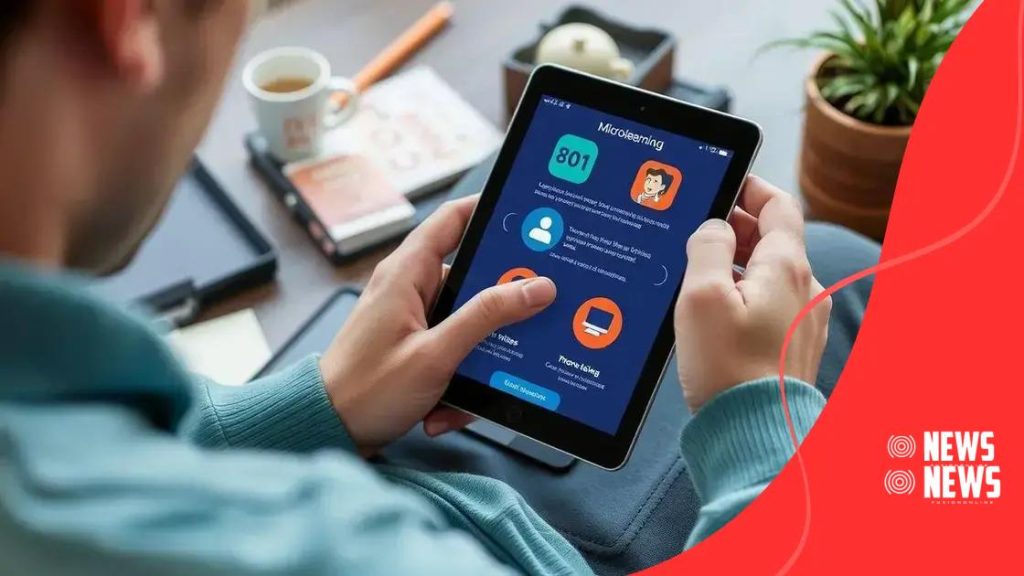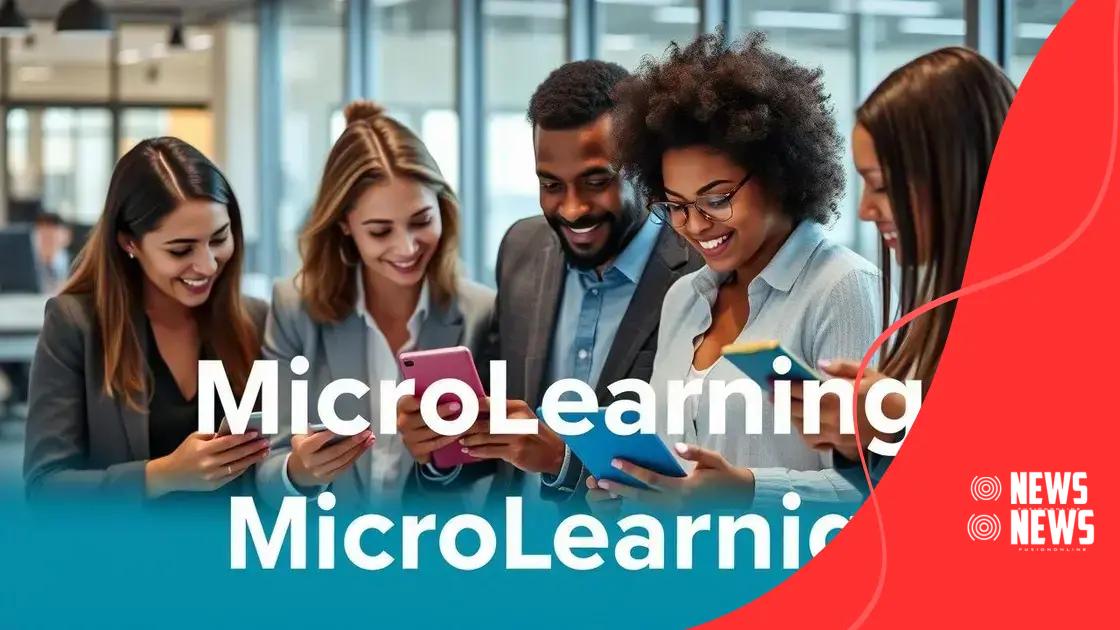The rise of microlearning: bite-sized education for everyone

The rise of microlearning provides an effective approach to education by delivering content in bite-sized formats that enhance retention and engagement, making learning flexible and accessible for diverse audiences.
The rise of microlearning: bite-sized education is changing how we approach learning today. Have you ever felt overwhelmed by traditional education formats? This approach offers a refreshing alternative that fits our fast-paced lives.
Understanding microlearning and its key concepts
Understanding microlearning is essential to appreciating its role in modern education. This approach focuses on delivering learning in small, digestible segments. It’s designed for quick consumption, making it perfect for busy professionals and students alike.
Microlearning can take various forms. You might encounter short videos, quizzes, or articles that deliver information effectively. These formats support learners by offering flexibility and convenience, fitting learning into their schedules.
Key Concepts of Microlearning
To grasp microlearning fully, we must explore its core concepts. These include:
- Focused content: Lessons are targeted and concise, ensuring learners grasp specific skills.
- Accessibility: With mobile technology, learning can occur anywhere, anytime.
- User engagement: Interactive elements boost motivation and retention.
- Regular reinforcement: Spaced learning helps solidify knowledge and skills over time.
These principles illustrate why microlearning has gained popularity. By breaking down complex topics, it encourages better understanding without overwhelming the learner. This format aligns well with today’s fast-paced world, making education more accessible and enjoyable.
In summary, microlearning takes education to new heights by focusing on smaller, manageable segments. It enhances learning experiences and caters to diverse needs. As we explore further, we’ll see how these concepts translate into effective strategies in education.
Benefits of bite-sized education
Bite-sized education offers many advantages that appeal to modern learners. This approach focuses on delivering knowledge in small, manageable segments. As a result, learners can engage better and absorb information more effectively.
One of the primary benefits is that it enhances retention. When information is presented in brief bursts, it is easier for learners to remember key concepts. This type of learning aligns with how our brains naturally process information.
Key Benefits of Bite-Sized Education
Here are some specific advantages:
- Flexibility: Learners can fit education into their busy schedules, allowing for on-the-go access anytime.
- Increased engagement: Short, interactive content keeps learners interested, making learning feel less like a chore.
- Instant feedback: Many bite-sized formats, like quizzes, provide instant responses, helping learners understand their strengths and weaknesses.
- Personalized learning: Individuals can choose topics that interest them most, customizing their learning journey.
This format also supports continuous learning. With bite-sized content, learners can revisit material whenever they need a quick refresher. This approach encourages a culture of ongoing education, rather than cramming before exams.
Incorporating bite-sized education into personal or professional development plans boosts skill acquisition. As learning becomes more accessible, it reduces barriers and democratizes education, allowing more individuals to thrive. Embracing this method may very well be the key to staying competitive in today’s fast-paced environment.
Effective microlearning strategies

To successfully implement microlearning strategies, it’s crucial to focus on practices that enhance the learning experience. By adopting the right methods, educators and organizations can maximize the effectiveness of bite-sized education.
One strategy involves creating short, engaging content. Videos, infographics, and quizzes can capture attention quickly and provide valuable information in a fun format. This approach keeps learners interested and encourages them to explore more.
Implementing Effective Microlearning Strategies
Here are some key strategies to consider:
- Define clear learning objectives: Start by identifying specific goals for each microlearning module. This helps focus the content and guides learners effectively.
- Leverage technology: Use apps and platforms that facilitate microlearning. These tools often include interactive features that enhance engagement and retention.
- Incorporate assessments: Short quizzes or polls can reinforce the material and provide immediate feedback, making learning more effective.
- Encourage social interaction: Foster discussions or collaborative projects among learners to promote a sense of community and deeper understanding.
Another effective strategy is to distribute learning sessions over time. Spaced repetition aids memory retention by allowing learners to revisit and reinforce content. This method can dramatically improve understanding and recall, especially for complex subjects.
Lastly, it’s important to maintain adaptability in microlearning. Continuously gather feedback from learners to refine and improve the materials. By being responsive to their needs, you can create an ever-evolving learning environment that truly benefits everyone.
Microlearning tools to consider
Choosing the right microlearning tools can enhance the learning experience. These tools should effectively deliver content in engaging and accessible formats. With numerous options available, selecting the best ones for your needs can make a significant difference.
One popular category of tools includes mobile applications. These apps allow learners to access bite-sized content on the go, making education flexible and convenient. Some examples of effective mobile microlearning apps include:
- Quizlet: This tool offers flashcards, quizzes, and games to help with studying.
- Khan Academy: Users have access to a vast library of short instructional videos covering many subjects.
- LinkedIn Learning: It provides a variety of courses, many of which are broken into brief video segments.
Another great option includes learning management systems (LMS). These platforms often feature microlearning modules, allowing educators to create courses that focus on concise lessons.
Popular Learning Management Systems
Consider these LMS when looking for microlearning solutions:
- TalentLMS: This user-friendly platform supports creating short, focused courses quickly.
- Docebo: Known for its engaging interface, it allows fine-tuning of learning paths tailored for individual users.
- Moodle: An open-source option that lets educators create and share microlearning content efficiently.
Microlearning can also be enhanced with various content creation tools. For instance, platforms like Canva allow users to design visual learning materials easily. These visuals can make understanding concepts simpler.
Lastly, incorporating gamification elements into microlearning can boost motivation and engagement. Platforms such as Kahoot! or Quizizz leverage competition and fun to reinforce learning.
Case studies of microlearning in action
Examining case studies of microlearning provides valuable insights into its practical application. These real-world examples show how organizations have successfully implemented microlearning strategies to enhance their training programs.
One notable example is a global tech company that revamped its onboarding process. By integrating short, interactive modules, new employees could learn essential skills quickly. Each module was focused on specific tasks, allowing employees to absorb information at their own pace.
Case Study: Tech Company Onboarding
In this case:
- Modules were completed in under 10 minutes: Each lesson focused on a single topic, such as using company software or understanding company culture.
- Immediate feedback: Quizzes followed each module, helping employees assess their understanding right away.
- Accessibility: Employees could access materials anytime on their devices, accommodating different schedules.
As a result, the company saw a significant increase in retention rates and employee satisfaction during the onboarding process.
Another impressive case involved a well-known retail chain that used microlearning to improve customer service. They developed bite-sized training sessions to address product knowledge and customer interaction skills. Employees completed these short sessions whenever they had downtime.
Case Study: Retail Chain Customer Service Training
Key components included:
- Short videos: Employees watched engaging videos demonstrating best practices.
- Role-playing scenarios: Interactive scenarios allowed employees to practice and enhance their skills in a safe environment.
- Performance tracking: Managers could track progress and offer support where needed.
This approach paid off; customer satisfaction scores improved, and employees reported feeling more confident in their interactions with customers.
FAQ – Frequently Asked Questions about Microlearning
What is microlearning?
Microlearning is a modern approach to education that delivers content in small, manageable segments to enhance retention and engagement.
How can microlearning improve employee training?
By providing short, focused lessons, microlearning allows employees to learn at their own pace, leading to better understanding and application of knowledge.
What tools are available for microlearning?
There are various tools like Quizlet, TalentLMS, and mobile apps designed to create and deliver bite-sized educational content effectively.
Why is feedback important in microlearning?
Feedback helps learners assess their understanding and progress, ensuring that any gaps in knowledge are identified and addressed promptly.





